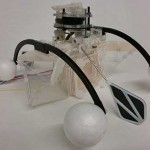 Earlier this month I looked at an automated device that was designed to make doing aquatic research easier and more effective.
Earlier this month I looked at an automated device that was designed to make doing aquatic research easier and more effective.
The devices, called Datamarans, are described by the company as self-deploying buoys and are equipped with low power computers and smart navigational equipment.
They are capable of maintaining their position for the duration of their work before then returning to base upon completion of their mission.
Automated cleanup
The trend for automated marine devices is continuing apace, with a team from Bristol Robotics Laboratory (BRL) developing a device that can feed off of polluted water, cleaning it as it goes.
The device, known as Row-bot, is documented in a recently published paper, and mimics the way swimming insects navigate the water.
The team believe that the device is capable of operating autonomously for an indefinite period by scavenging energy from the environment it’s swimming in.
It’s capable of consuming up with water, and its microbial fuel cell converts the nutrients in the water into energy. The device bio-degrades the organic matter to generate the energy to move.
Once recharged, the Row-bot is then able to swim off to a new location to gulp down some more dirty water.
“The work shows a crucial step in the development of autonomous robots capable of long-term self-power. Most robots require re-charging or refuelling, often requiring human involvement,” the team say.
Boldly going
The team hope that the device will come into its own in areas such as environmental clean up operations, and in environmental monitoring of toxic environments.
The device consists of two distinct parts:
- A bioinspired energy source
- Bio-inspired actuation
The second part is the interesting aspect as it begins the refuelling process and handles the movement of the robot. This movement is achieved using less energy than what is generated using the first part.
The ‘feeding’ process mirrors that of the water boatman. The boatman uses a broad, beaklike mouth to scoop up fluid and any particulate matter that is suspended within it.
The Row-bot opens a mouth at either end of itself to feed the ‘stomach’ section and capture enough energy to be completely self reliant.
That's pretty neat, and you can certainly see that being used in environmental clean up operations and so on.
It would be interesting to know just how pure the water is after it has been processed by the robot's 'stomach.' There is a growing demand for potable water and, as they say, "every little helps."
haha. Row-bot the robot.
This is VERY cool. It could have huge fuel-type implications.
Seriously cool. Wow, Bionic robotics! Technology is just epic
Interesting, how does it handle becoming clogged, perhaps a self dumping?
This is indeed very cool, but I have to wonder – How much "cleaning" can one robot do and how much inorganic waste will be created in order to manufacture the bazillions of these things that would likely be required to make a noticeable difference?